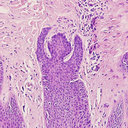Pathogenesis of chronic cluster headache and bouts: role of tryptamine, arginine metabolism and α1-agonists.
Nyckelord
Abstrakt
The aim of this study was to explore the possible role of tryptamine in the pathogenesis of chronic cluster headache along with that of adrenaline and noradrenaline (α-agonists) together with arginine metabolism in the origin of cluster bouts. Plasma levels of tyramine, tryptamine, serotonin, 5-hydroxyindolacetic acid, noradrenalin, adrenalin and the markers of arginine metabolism such as arginine, homoarginine, citrulline, ADMA and NMMA, were measured in 23 chronic cluster headache patients (10 chronic cluster ab initio and 13 transformed from episodic cluster) and 28 control subjects. The plasma levels of tyramine, tryptamine, noradrenalin and adrenalin were found several times higher in chronic cluster headache patients compared to controls, whereas the plasma levels of arginine, homoarginine and citrulline were significantly lower. No differences were found in the plasma levels of serotonin, 5-hydroxyindolacetic, ADMA and NMMA between chronic cluster headache patients and control subjects. These results provide support for a role of tryptamine in the pathogenesis of chronic cluster headache and, in particular, in the duration of the cluster bouts. In addition, the low levels of the nitric oxide substrates together with the high levels of noradrenalin and adrenalin suggest an activation of endothelial TAAR1 receptors followed by the release of nitric oxide in the circulation that may constitute the final step of the physiopathology of cluster crisis.


